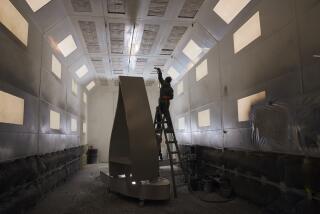Ironworkers union gives skills to members, public safety to all
“These guys are soft right now,” Paul Martinez said. “They’re going to struggle.”
He was right. We were watching a group of apprentice ironworkers with hard hats on their heads and 35-pound tool belts around their waists trying to climb a vertical girder, using nothing but hand strength and the leverage of their work boots on slippery steel. The girder was marked at 10 feet with a strip of white tape. That was the finish line. As we watched, one made it and eight failed. Some could barely get one foot off the ground before giving up.
“By Friday, they’ll all be making it,” Martinez said.
Martinez, 47, knows what he’s talking about. He’s a third-generation ironworker born and bred in San Pedro. He joined the ironworkers union in 1984 and helped put up the Los Angeles Convention Center, the Anaheim Pond and the new tower at LAX. Since 1998 he’s been the coordinator of the apprenticeship training program for Ironworkers locals 416 and 433, which operates out of a squat industrial building in La Palma.
Every six months the program graduates 50 to 80 workers from apprenticeship to journeyman status. The upgrade roughly doubles their hourly wage to about $33 (plus about $22 an hour in retirement and health benefits) and certifies that they’ve had four years of training in the latest techniques of bridge and building construction, welding, and safety. That’s four years of classroom instruction and physically taxing hands-on training on the program’s model work site out back, doled out at the rate of one full week every three months, with the rest of the time devoted to on-the-job experience.
“For some of these kids, this is the first thing they’ve ever graduated from in their lives,” says Robbie Hunter, executive secretary of the building and construction trades council of Los Angeles and Orange counties and a former Ironworkers president.
“Kids” may be a misnomer. The average age of the apprentices is about 32, which tells you a bit about the convoluted life paths some followed before landing in a program providing them with a ladder to the middle class. Some worked in dead-end jobs stacking boxes in warehouses. Some had felony records, including gang-related offenses.
“Once they come here and find their second family with us, they transition away from that,” Martinez told me. “This is a path out of that lifestyle, so you can move to someplace like Apple Valley and raise your kids in a safe environment.” Women generally make up about 5% of the class.
The La Palma program is a rebuke to the all-too-popular stereotype that a union exists only to provide featherbedding for workers and fat salaries for officers. This is one of the ways a union demonstrates its importance: by bringing the next generation along and doing its part to uphold standards of construction technique and workplace safety that save lives, including those of the people who live and work in and drive on the projects they built.
The Southern California construction trade isn’t a closed shop — midsize projects are 60% to 70% unionized, Hunter estimates — but on major sites such as skyscrapers and bridges the ratio is close to 100%, and for good reason: If you’re in an office or a hotel room 50 or 60 stories high or careening around a roller coaster at 60 miles per hour, wouldn’t you want to know that the workers who built it had the best training available, as well as the pride and dignity that comes from a living wage and the prospect of a humane retirement?
That’s the true theme of the Labor Day we’re about to celebrate; not, as you may have been led to believe, that the end of summer is the perfect time for a Toyotapalooza.
Getting into the ironworkers apprenticeship program isn’t a snap. It may help to have a relative, or even a well-wishing neighbor or family friend, in the Ironworkers, but that’s not a prerequisite, nor is it enough. Applicants, who have to be at least 18 with a high school diploma or equivalent, must line up a construction contractor willing to sponsor them with at least six weeks of employment before they can start. That explains why, with the local construction market still soft and the building trades still suffering from about 40% unemployment, there’s a waiting list of about 5,000 applicants looking for sponsors right now.
They have to come in with the right mind-set. They’ll be clambering up steel girders and over beams, laying corrugated decking and hauling steel tubes and rebar, and doing so loaded down with tools and bolts. They’ll be playing with fire, handling torches in the La Palma facility’s welding shop.
“They’ve got to want it, they’ve got to love it,” Dennis Skoug, the apprenticeship program’s welding instructor, told me. “If they’re coming just because their father told them to get off the couch, they’re not going to make it.”
They’ll be learning that this is a job that demands your full attention. There’s a stack of manuals and workbooks to pore over, covering how to read blueprints, do math, work with cranes. The reference manual for structural steel alone runs to more than 400 pages, describing how to erect and install the joists, beams, decks and sheeting that go into a high-rise building, a bridge, a wind turbine or a roller coaster.
The program is made for people like Jared Shoultz, a burly 32-year-old in his eighth period, meaning he’s in the last half-year of the four-year program. Shoultz was born in Northern California, grew up in group and foster homes, served in the Navy and was trying to make a go of it in San Jacinto as a personal trainer when he lucked into a construction job at a nearby power plant project.
It was a nonunion site except for union electricians. “All you needed to know about the job was written on the Porta-Potties,” he recalled. “I came out and asked someone, ‘What’s a scab?’”
After learning about the apprenticeship program, he found his first sponsor in Santa Barbara, which meant spending weeks commuting to work by motorcycle. As we talked he was setting up a welding station to sharpen his skills for an advanced certification and also get ready to match his skills against ironworker apprentices from all over the country and Canada at the biennial apprentice competition this month in Indianapolis. Think of it as a workers’ Olympics, with eight events covering knot tying, welding and climbing a 35-foot column, among other skills. There’s also a written test with 100 questions.
It’s conceivable that an apprenticeship program of this magnitude could be staged outside a union setting, but it’s hard to figure out who would take on the responsibility. Union members understand that “your pension depends on the next guys coming up, and they have to be trained,” Martinez says. The union sees to it through collective bargaining that the employers support the program with a contribution based on hourly payroll and that a ratio of 1 apprentice to every 4 journeymen is maintained on major work sites.
But maintaining that support takes a constant struggle. The construction trade unions will be pulling out all the stops to beat Proposition 32, the massively dishonest union-bashing initiative on the November ballot, because they know that if it silences their voice in Sacramento, the harvest could be the destruction of pay and workplace standards, first on public works construction sites and then everywhere else. Nonunion labor is cheap, and isn’t that what it’s all about?
“People don’t remember what the union is all about,” Martinez told me as we toured the classrooms and training field of his center, laid out like an obstacle course of girders and beams. “It’s about people who choose to negotiate to make their lives better.”
Michael Hiltzik’s column appears Sundays and Wednesdays. Reach him at mhiltzik@latimes.com, read past columns at latimes.com/hiltzik, check out facebook.com/hiltzik and follow @latimeshiltzik on Twitter.
More to Read
Sign up for Essential California
The most important California stories and recommendations in your inbox every morning.
You may occasionally receive promotional content from the Los Angeles Times.











